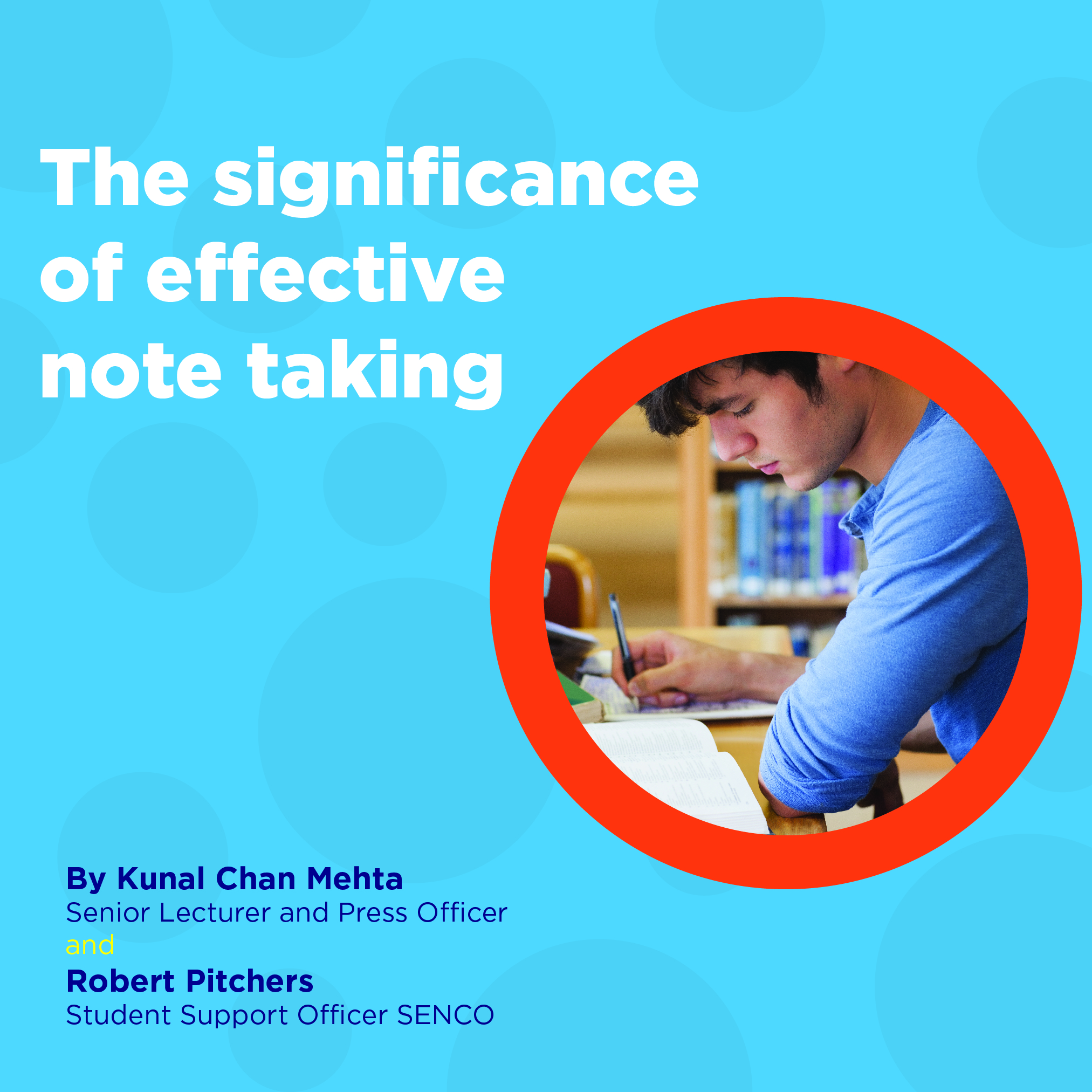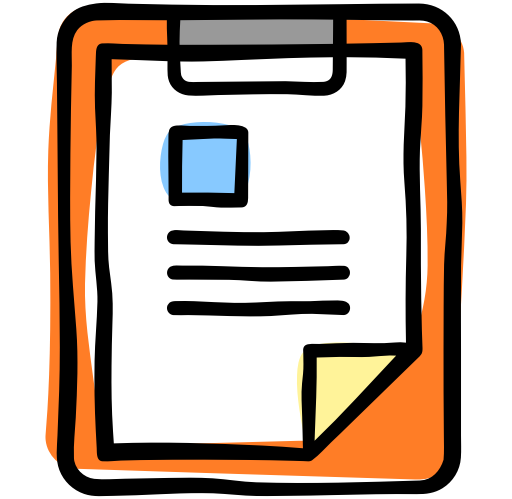The significance of effective note taking
Article Date | 7 June, 2018
07 June 2018 By Kunal Chan Mehta, Senior Lecturer and Press Officer and Robert Pitchers, Student Support Officer SENCO
Note taking, as a professional skill, can often be overlooked by students. We often forget things as quickly as we hear them, so good note taking helps you abridge discussions and keep a record of conversations that took place. It is a key skill that you can practice in-class, out-of-class and throughout your career.
One of the most effective ways to remember what you are learning is to take effective notes in class. It sounds obvious – but good note taking keeps you on top of things. Conversely, ensuring that note-taking is effective takes time and practice to master.
“If it feels like you forget new information almost as quickly as you hear it, even if you write it down, that’s because we tend to lose almost 40% of new information within the first 24 hours of first reading or hearing it. If we take notes effectively, however, we can retain and retrieve almost 100% of the information we receive”. Brown, C, (2015)
Different note taking methods work better for different students. There is no right or wrong way to do it but you should find out what works best for you by testing different note-taking methods. To improve your note-taking skills in class, here are our top tips:
1. Before each lecture Read through relevant lecture slides or handouts as well as your notes from the previous lecture to ensure preparedness. This will facilitate note-taking and assist you in understanding related subsequent topics. Over time, you will also be able to tidy-up your notes as you read them and relate them back to wider course content. 2. Engage with the lecturer It is important to engage with the lecturer as much as possible. This helps you take in and understanding what the lecturer is saying as you note it down. Many students find that their notes do not make sense a few days after taking them down – so be sure to check them shortly after the lecture ends. 3. Use the Cornell Method The Cornell Method is one of the most popular note-taking methods amongst students. You divide up your notes into three sections. (1) The right column is where you keep your most important ideas that the lecture has covered. (2) The left margin serves to compliment the general area in (1) and helps you understand and relate to each part of the notes. It serves as a ‘recall’ section that you update after each class. (3) The last section labelled ‘summary’ is left blank during class as it is intended for use when you are reviewing and studying the class notes. You should try to develop a short summary of key points in this section for a greater reflection of the class notes. This will be useful for revision notes too. For more details on the method see: https://www.wikihow.com/Take-Cornell-Notes 4. Create your own symbols and abbreviations These will come handy during lectures and can help you save time and stay structured. Practice makes perfect. Why not have a look at some examples from the EAP Foundation: http://www.eapfoundation.com/listening/notetaking/symbols/ 5. Separate different notes Why not use different coloured pens or highlighters to visually distinguish your notes? For example, further reading actions could be in blue, theoretical points in red and key revision notes in green. Also, underline or highlight key points. This simple activity is very effective as it allows you to refer straight back to key points with ease after your lecture. 6. Do not overdo it There is no need to make notes on everything. This will create frustration during your lecture and possible confusion later. Rather, summarise key points in your own words – taking down notes verbatim may even hold you back from recording key information. 7. Bring a notepad and/or electronic device to every lecture It is important to keep all key pieces of information in one place and ensure you do not miss anything out. Make a habit of organising and collating your notes from each lecture. 8. At the end of each lecture Spend around 10 minutes making sense of your notes and summarising key points with other students to ensure orientation. It is best to do this straight after a lecturer while the class debate and discussion is still fresh. 9. Practice taking notes outside the class room Attempt to take notes while watching television debate shows, TED talks or while listening to radio shows. Practice makes perfect. 10. Learning how to retain information Note taking skills involves active rather than passive learning. Active learning identifies the responsibility of learning by the learner themselves. Research shows that for learning to be most effective, learners need to be active with the materials they are engaging with – such as reading, writing, discussing and solving problems (Bonwell, 1991). You can also consider metacognition skills that require full engagement with the material being used:
“While students are learning the content, they should also be thinking about how they are learning it. What is causing confusion? How does your thinking change about this topic as you are learning? What has worked well for you in learning this topic that you should do next time? What hasn’t worked so well so you don’t make that learning mistake again? “ (Bransford, Brown, Cooking, 2000, p18)
Hattie (2011) suggests that note taking is most effective when the notes are organised in an appropriate structure. This requires effort from the learner; the lecturer needs to explain to the learner to help them understand the reasons for taking notes. German psychologist Hermann Ebbinghaus in 1895 conducted some of the first experiments on memory and recall, and spaced learning. He developed the forgetting curve, which shows how information is lost over time if there is no strategy or effort to retain it (Brown, 2015).

In summary, the significance of effective note taking is to help recall what has been learned and retain that information over time. Use the above tips to help you build more organised and effective notes. In turn, these will help you remember concepts, develop meaningful learning skills, and gain a better understanding of a topic. Please email Kunal Chan Mehta, Senior Lecturer and Press Officer or Robert Pitchers, Student Support Officer SENCO for any further information or support on this blog. References Bransford, Brown, Cooking, 2000, p18) “Metacognitive approach to instruction” Cited in Chick, N, (no date) Thinking about one’s thinking available from https://cft.vanderbilt.edu/guides-sub-pages/metacognition/ accessed date 6th June 2018 Brown, C, (2015) “The Conversation what’s the best most effective way to take notes” available from https:// the conservation.com/whats–the-best–effective–way–to–take–notes-41961 accessed date 6th June 2018 Bornwell, C, C; Elson, J, A, (1991) “Active Learning: Creating Excitement in the Classroom” Washington: ERIC Publications Cited in Brown, C, (2015) “The Conversation what’s the best most effective way to take notes” available from https:// the conservation.com/whats–the-best–effective–way–to–take–notes-41961, accessed date 6th June 2018 Chi-Ming Ho, (2009), “Forgetting Curve” Cited in Brown, C, (2015) The Conversation what’s the best most effective way to take notes available from https:// the conservation.com/whats–the-best–effective–way–to–take–notes-41961 accessed date 6th June 2018 Hattie, J, (2011) “Visible Learning: for Teachers’ Maximizing Impact on Learning” Cited in Brown, C, (2015) “The Conversation what’s the best most effective way to take notes” available from https:// the conservation.com/whats–the-best–effective–way–to–take–notes-41961 accessed date 6th June 2018
How to reference this article:
Mehta, K (2018) and Pitchers, R (2018) The significance of effective note taking. LSST Staff Blog. 8th June. Available at https://www.lsst.ac/blogs/the-significance-of-effective-note-taking [Add the date you accessed the article here]
11 thoughts on “The significance of effective note taking”
Comments are closed.





Thanks
This is really helpful.Thanks to the authors of this work. I actually feel better at taking notes and learning. I thank you again
I think this blog is actually simple stuff but I needed reminder of the way of note taking in class and that makes me want to say thanks for putting this together.
I wish to remain anonymous but am a student in the Luton LSST.
That is fine. Thank you for this interesting view.
I really like this comment section. Note taking is not about skills only as this article focuses on as it is about lecturers too. So student and staff need to work in collaborative.
This is very helpful and thank you to staff at lsst London to put this online for me to use.